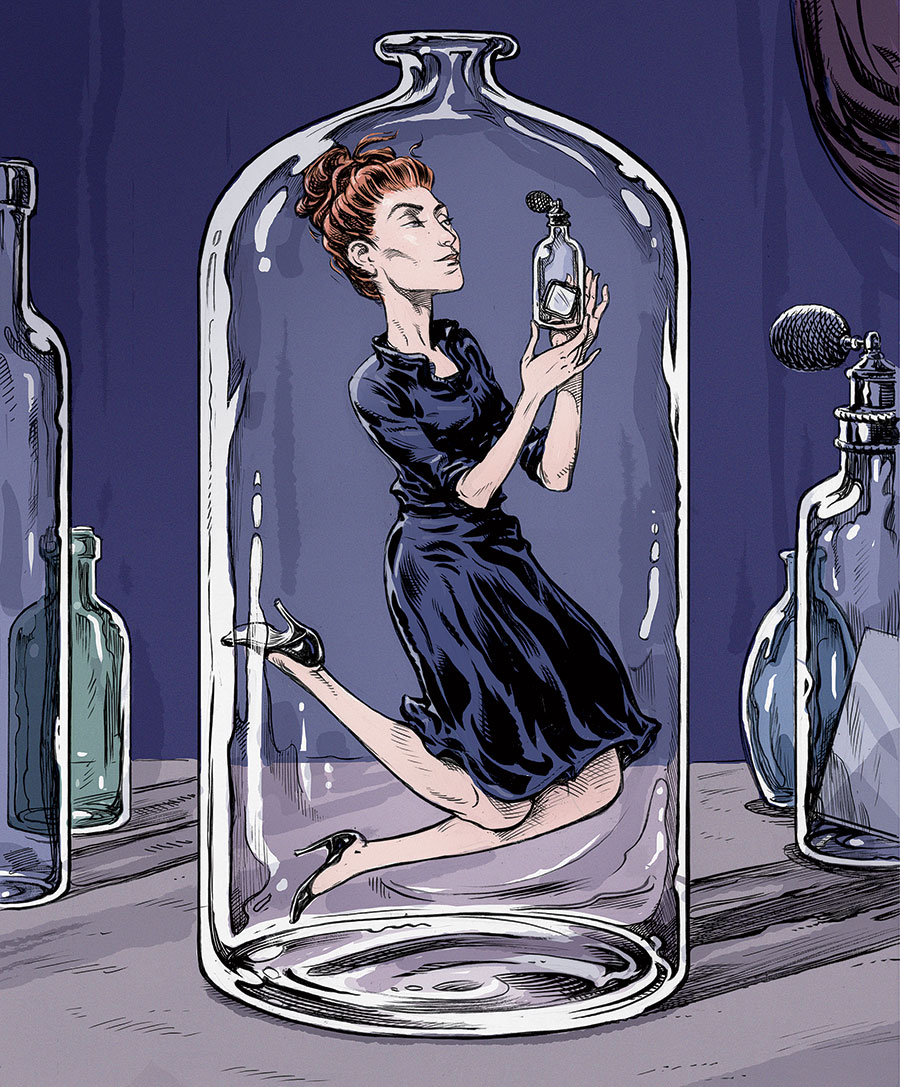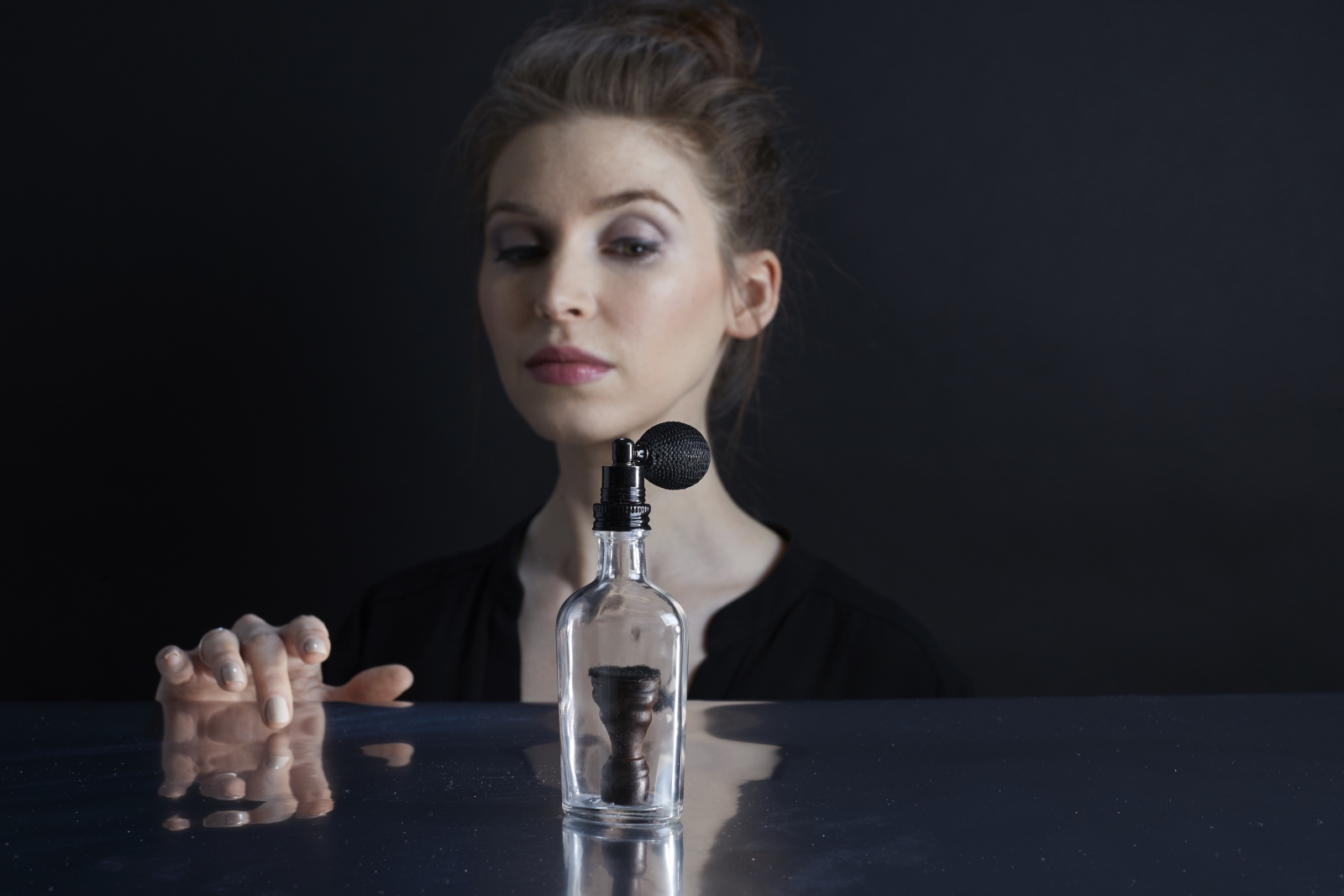
What I was looking at was impossible. It made no sense. Yet it existed.
In front of me was a glass bottle, about five inches tall. Inside it was a compact mirror, the type you get at Walgreens for a few dollars. The mirror was roughly twice as wide as the mouth of the bottle. The bottle had not been altered. The mirror had not been cut. Yet somehow the creator of this strange and beautiful discordance, Jeanette Andrews, had found a way to fit the one inside the other, using a method that took her a year of single-minded devotion to develop.
If you’re looking to learn how Andrews did it, feel free to stop reading now. Andrews, a 29-year-old magician who lives on the North Side, won’t say. Lest you believe this ruins the story, understand that even I didn’t want to know. It’s not just about respecting a magician’s modus operandi. As a magic hobbyist for more than 30 years, I have discovered this strange quirk about the nature of secrets: Almost always, learning the truth behind them is disappointing. The bewilderment you experience pre-knowing-how-something-is-done vanishes, if you will, once you peek behind the proverbial curtain. So I’ve come to appreciate what the magician Paul Harris calls the “moment of astonishment”: that split second when your brain short-circuits, you do a double-take, and a “Whaaaat?” escapes your lips. Some people are unsettled by the idea of not being in control of their cognitive reality, but personally, I enjoy feeling like a child again.
Andrews’s origin story starts with her at the age of 4, sitting in her family’s living room in Wheaton, a bowl of popcorn in front of her. On the television are white tigers, glittering costumes, and soaring music — a Siegfried & Roy magic special. The young girl’s eyes widen. A switch flips inside her, and a light turns on that will never go out again.
For most, magic is a passing fancy at best, a hobby for entertaining obliging aunts and uncles at Thanksgiving. Andrews stuck with it and now makes a living from it. The type of magic she performs involves no animals or large boxes with trapdoors or “Ta-da!” flourishes; her shows are imbued with an artsier, more cerebral sensibility. In 2017, the Museum of Contemporary Art Chicago commissioned a performance piece from her called Invisible Roses. Audience members were handed a blank piece of paper and given a set of instructions consisting of two words: “Locate Roses.” After finding a room in the museum that contained 1,200 live roses in vases resting on sod, visitors were asked to take a flower and brush the blank piece of paper with the petals. A map to a secret performance area, printed in invisible ink, appeared.
About 10 years ago, Andrews first laid eyes on what is known in puzzle-making and magic circles as an “impossible bottle.” She remembers an everyday object — it might have been a deck of playing cards or a tennis ball, she’s no longer certain — placed inside a glass bottle. She can still taste the feeling of wonderment, like she was gazing at an M.C. Escher staircase in real life.
The godfather of the impossible bottle was an elementary school teacher in San Diego named Harry Eng. Most people have seen model ships inside a bottle, and most know the painstaking method for assembling them. The contents of Eng’s bottles, though, defied explanation: padlocks, baseballs, light bulbs, a knotted nautical rope tied to a deck of playing cards impaled by a steel bolt. Eng never revealed how he accomplished his magic, taking his secrets to the grave. An obituary in the October 1996 issue of Genii magazine said of Eng: “Harry put things in bottles to challenge himself and to make people think.”
Those seeking to emulate Eng essentially have to reverse-engineer his creations. “There’s no instruction manual,” says Gabe Fajuri, a magic historian and president of Potter & Potter, a Chicago auction house specializing in antique magic collectibles. “The few people I know who make these things, they keep it to themselves.” When asked how many people in the world can produce an impossible bottle, Fajuri estimated half a dozen.
The impetus for Andrews’s impossible bottles arose not from objects but from scent. One of the tricks she’d been working on involved handing someone an empty perfume bottle, filling it with water, and having a second audience member think of a random scent — say, cedarwood. When the spectator sprayed the atomizer — voilà! — cedarwood. The idea of incorporating impossible bottles into her show intrigued her.
There are instructional videos on YouTube showing people bending and unbending playing cards to fit them inside a bottle, or using long tweezers to reassemble a broken-apart Rubik’s Cube. But such clips would have proved useless for the first impossible bottle objects Andrews had in mind, which included, among other things, a potted flower.
A breakthrough came in June 2018 while she was in New York City visiting the Conjuring Arts Research Center, a library of historical magic texts that requires visitors to obtain approval from the center’s board before they can even make an appointment. With just 10 minutes remaining of Andrews’s allotted time, a librarian called her over: Buried inside an obscure mathematics journal was a four-sentence passage from an interview with Harry Eng, in which he alluded to one of his methods. It wasn’t the method Andrews would need, but it was a trigger that sent her in the direction she needed to go.

She began learning everything she could about bottles — the history of glass production, the classification of screw caps, differences in turn radius. Andrews would frequent the thrift store near her home several times a week, picking up any bottles donated that day.
Her first forays hit dead ends. A promising lead would prove infeasible, as would the next, and so it went for nearly a month. “In some ways I am my work, and my work is me,” Andrews says. “So any failure within my work is totally inseparable from who I am as a person.”
Then, while walking through her local arts and crafts store, Andrews had a flash of inspiration. Again, it was not the exact method she needed, but another nudge forward. After weeks of frustration — “a lot of tears and a lot of stress” — the moment felt like a small victory.
Soon every free surface in Andrews’s studio apartment was occupied by bottles, around 300 by her estimate. By this point, even her best friend and her father were not allowed to visit. She’d open the door only for her mother, Caryn, who became a sounding board, a beacon of encouragement. “I would keep reminding her that she overcame things in the past,” Caryn says. “I kept saying, ‘You’ll get it.’ ”
By August, Andrews was able to fit a red Lego brick inside a miniature glass vase. And yet it took her another five months — by now it was the middle of winter, almost a year after she’d first embarked on the creation of impossible bottles — just to figure out the objects she wanted to enclose in the bottles to be used in her show: a sealed deck of playing cards, a wooden chess rook, a compact mirror, and the potted flower, which she decided would be a single white rose.
During one grueling stretch, she didn’t leave her house for two days. Friends suggested she go out more, enjoy life, meet new people, be a normal 20-something living in the city. She shrugged them off. “I could be getting a lot done in this time, doing the things I’d rather be doing,” she recalls thinking.
It wasn’t until this March that Andrews finally got the objects into their bottles. Her achievement did not involve a eureka moment when the object dropped inside and clinked to the bottom, but rather was the result of months of slow, arduous trial and error. Beyond that, she will reveal only that neither glass nor object was cut and that 3D printing was in no way involved. The basic idea could be explained in three words, she says, but the process “is so complicated and so labor-intensive, people would think, ‘Oh my God, this is insane.’ ”
The bottles are currently being used in a magic show she wrote called Bottling the Impossible, which Andrews debuted in June at Mana Contemporary Chicago, an arts center and performance space in Pilsen. (The show will be performed at the Elmhurst Art Museum on October 17.) This was where I first encountered the bottle housing the compact mirror. She brandished it like a magic wand before launching into a trick in which she names a number and a playing card that a random audience member had been thinking of.
Watching Andrews use the bottled mirror to introduce her mind-reading trick, I couldn’t help but think of her painstaking endeavor as some kind of metaphor. Perhaps it was this: For over a year, Andrews had struggled to think her way into a bottle, and now she could look inside, see her own reflection, and know that she’d succeeded.


